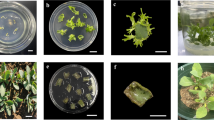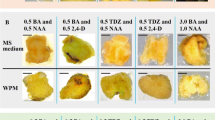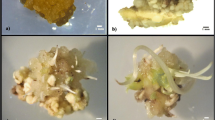Abstract
The frequently occurring browning of plant tissue cultures is a considerable problem in causing economic losses. However, the mechanism that causes browning of plant tissues is still controvesial and technologies to effectively prevent browning of plant tissues are still scarce. In the present work, two callus lines derived from grapevine shoot tips (ST-callus) and fruit flesh (F-callus) were used to investigate the relationship between callus-associated endophytes and callus browning. We observed the transfer of browning effects from grapevine brown calli to normal calli, in a contact cocultivation experiment, then detected the emergence of endophytic bacteria from brown calli when the calli were incubated in a microbial culture medium, and the isolates were identified as genus Bacilus. The inoculation of pure cultured B. sp. strain ST-B1 into normal calli at different concentrations caused gradient callus browning, validating the callus browning-causing (CBC) endophyte. In addition, the moderate inhibition of endophytic bacteria in grapevine calli by culturing the calli in ampicillin-containing media reduced the incidence and severity of callus oxidative browning. The experiments were performed separately on two types of grapevine calli, ST-callus (derived from the tip of grapevine shoots), and F-callus (derived from the pulp of grape berries), and gave similar results. The DNA sequence amplicon approach showed that the CBC endophytic bacteria were found in both the normal and brown calli, which differed greatly in their relative abundances. And compared to the normal calli, brown calli greatly reduced the diversity of bacterial endophytes, while the diversity of fungal endophytes between normal and browning calli showed no obvious difference. The work demonstrated that callus-associated endophytes are involved in causing oxidative browning of plant cells, and suggested technologies to minimize the occurrence of the oxidative browning during plant tissue culture practices.
Key message
The study revealed a mechanism by which the callus-associated endophytes are causations in triggering oxidative browning of plant cells, and the maintanence of endophytic bacterial balance is fundamental to a healthy callus. The work also suggested technologies to minimise the occurrence of browning during plant tissue culture practices.








Similar content being viewed by others
Data availability
All data and materials are available in the manuscript; raw data of high throughput sequencing for the grape calli were deposited at NCBI under the Accession Number PRJNA868149.
References
Amente G, Chimdessa E (2021) Control of browning in plant tissue culture: a review. J Sci Agric 5:67–71
Beckman CH (2000) Phenolic-storing cells: keys to programmed cell death and periderm formation in wilt disease resistance and in general defence responses in plants? Physiol Mol Plant Pathol 57(3):101–110. https://doi.org/10.1006/pmpp.2000.0287
Bressan W, Figueiredo J (2008) Efficacy and dose–response relationship in biocontrol of fusarium disease in maize by Streptomyces spp. Eur J Plant Pathol 120(3):311–316
Chugh S, Guha S, Rao IU (2009) Micropropagation of orchids: a review on the potential of different explants. Sci Hort 122(4):507–520
Dhindsa R, Plumb-Dhindsa P, Thorpe T (1981) Leaf senescence: correlated with increased levels of membrane permeability and lipid peroxidation, and decreased levels of superoxide dismutase and catalase. J Exp Bot 32(1):93–101
Feng D, Wang Y, Chen J (2015) Research progress of browning in the plant tissue culture. Acta Agric Zhejiangensis 27(6):1108–1116
Gaff D, Okong’O-Ogola O (1971) The use of non-permeating pigments for testing the survival of cells. J Exp Bot 22(3):756–758
Gao J, Xue J, Xue Y, Liu R, Ren X, Wang S, Zhang X (2020) Transcriptome sequencing and identification of key callus browning-related genes from petiole callus of tree peony (Paeonia suffruticosa Cv. Kao) cultured on media with three browning inhibitors. Plant Physiol Biochem 149:36–49. https://doi.org/10.1016/j.plaphy.2020.01.029
Heath RL, Packer L (1965) Effect of light on lipid peroxidation in chloroplasts. Biochem Biophys Res Commun 19(6):716–720. https://doi.org/10.1016/0006-291X(65)90316-5
Jones A, Saxena P (2013) Inhibition of phenylpropanoid biosynthesis in Artemisia annua L.: a novel approach to reduce oxidative browning in plant tissue culture. PLoS ONE 8(10):e76802
López Arnaldos T, Muñoz R, Ferrer MA, Calderón AA (2001) Changes in phenol content during strawberry (Fragaria× ananassa, cv. Chandler) callus culture. Physiol Plant 113(3):315–322
Lorenzo JC, de Angeles Blanco M, Peláez O, González A, Cid M, Iglesias A, González B, Escalona M, Espinosa P, Borroto C (2001) Sugarcane micropropagation and phenolic excretion. Plant Cell Tissue Organ Cult 65(1):1–8. https://doi.org/10.1023/A:1010666115337
Murata M, Nishimura M, Murai N, Haruta M, Homma S, Itoh Y (2001) A transgenic apple callus showing reduced polyphenol oxidase activity and lower browning potential. Biosci Biotechnol Biochem 65(2):383–388. https://doi.org/10.1271/bbb.65.383
Nishioka T, Tamaki H (2022) Improved cultivation and isolation of diverse endophytic bacteria inhabiting Dendrobium roots by using simply modified agar media. Microbiol Spectr: E. https://doi.org/10.1128/spectrum.02238-22
Oita S, Carey J, Kline I, Ibáñez A, Yang N, Hom EF, Carbone I, U’Ren JM, Arnold AE (2021) Methodological approaches frame insights into endophyte richness and community composition. Microb Ecol 82(1):21–34. https://doi.org/10.1007/s00248-020-01654-y
Padró MDA, Caboni E, Morin KAS, Mercado MAM, Olalde-Portugal V (2021) Effect of Bacillus subtilis on antioxidant enzyme activities in tomato grafting. PeerJ 9:e10984
Pandey S, Sundararajan S, Ramalingam S, Pant B (2020) Effects of sodium nitroprusside and growth regulators on callus, multiple shoot induction and tissue browning in commercially important Valeriana jatamansi Jones. Plant Cell Tissue Organ Culture (PCTOC) 142(3):653–660. https://doi.org/10.1007/s11240-020-01890-7
Payghamzadeh K, Kazemitabar SK (2011) In vitro propagation of walnut—a review. Afr J Biotechnol 10(3):290–311
Permadi N, Nurzaman M, Alhasnawi AN, Doni F, Julaeha E (2023) Managing lethal browning and microbial contamination in Musa spp. tissue culture: synthesis and perspectives. Horticulturae 9(4):453
Pirttilä AM, Podolich O, Koskimäki JJ, Hohtola E, Hohtola A (2008) Role of origin and endophyte infection in browning of bud-derived tissue cultures of scots pine (Pinus sylvestris L.). Plant Cell Tissue Organ Cult 95(1):47–55. https://doi.org/10.1007/s11240-008-9413-x
Poveda Arias J (2022) Effect of volatile and non-volatile metabolites from Leptosphaeria maculans on tomato calli under abiotic stresses. Plant Stress 3:100054
Poveda J, González-Andrés F (2021) Bacillus as a source of phytohormones for use in agriculture. Appl Microbiol Biotechnol. https://doi.org/10.1007/s00253-021-11492-8
Tang W, Newton RJ, Outhavong V (2004) Exogenously added polyamines recover browning tissues into normal callus cultures and improve plant regeneration in pine. Physiol Plant 122(3):386–395. https://doi.org/10.1111/j.1399-3054.2004.00406.x
Thomas P, Franco C (2021) Intracellular bacteria in plants: elucidation of abundant and diverse cytoplasmic bacteria in healthy plant cells using in vitro cell and callus cultures. Microorganisms 269(9):1–27. https://doi.org/10.3390/microorganisms9020269
Xiang S-Y, Wang Y-T, Chen C-X, Liao C-M, Li T, Pan X-X, Zhu S-S, Yang M-Z (2023) Dominated inheritance of endophytes in grapevines from stock plants via in vitro-cultured plantlets: the dawn of plant endophytic modifications. Horticulturae 9(2):180. https://doi.org/10.3390/horticulturae9020180
Zhang K, Su J, Xu M, Zhou Z, Zhu X, Ma X, Hou J, Tan L, Zhu Z, Cai H (2020) A common wild rice-derived BOC1 allele reduces callus browning in indica rice transformation. Nat Commun 11(1):1–15. https://doi.org/10.1038/s41467-019-14265-0
Zhang J, Sun X (2021) Recent advances in polyphenol oxidase-mediated plant stress responses. Phytochemistry 181:112588. https://doi.org/10.1016/j.phytochem.2020.112588
Acknowledgements
This work was financially supported by the joint foundation of the Yunnan Provincial Department of Science and Technology and Yunnan University (No. 2019FY003024); the Yunnan provincial key S&T special project (202102AE090042-02-04), and the National Natural Science Foundation of China (NSFC: 32360255; 31560538).
Funding
This work was supported by the joint foundation of the Yunnan Provincial Department of Science and Technology and Yunnan University (No. 2019FY003024); the Yunnan provincial key S&T special project (202102AE090042-02-04), and the National Natural Science Foundation of China (NSFC: 32360255; 31560538).
Author information
Authors and Affiliations
Contributions
M-ZY, S-SZ, X-XP contributed to the study conception and design. Material preparation, data collection and analysis were performed by M-ZY, Y-TW, C-XC, PZ, C-XL, YW, YL. The first draft of the manuscript was written by M-ZY, X-XP, Y-TW, and all authors commented on previous versions of the manuscript. All authors read and approved the final manuscript.
Corresponding authors
Ethics declarations
Conflict of interest
The authors declare they have no conflict of interests exists in the manuscript, and manuscript is approved by all authors for publication. I would like to declare on behalf of my co-authors that the work described was original research that has not been published previously, and also not under consideration for publication elsewhere, in whole or in part.
Additional information
Communicated by Klaus Eimert.
Publisher’s Note
Springer Nature remains neutral with regard to jurisdictional claims in published maps and institutional affiliations.
Supplementary Information
Below is the link to the electronic supplementary material.
Rights and permissions
Springer Nature or its licensor (e.g. a society or other partner) holds exclusive rights to this article under a publishing agreement with the author(s) or other rightsholder(s); author self-archiving of the accepted manuscript version of this article is solely governed by the terms of such publishing agreement and applicable law.
About this article
Cite this article
Wang, YT., Chen, CX., Zhou, P. et al. Maintenance of callus-associated endophyte balance to mitigate oxidative browning in plant tissue culture practices. Plant Cell Tiss Organ Cult 157, 41 (2024). https://doi.org/10.1007/s11240-023-02669-2
Received:
Accepted:
Published:
DOI: https://doi.org/10.1007/s11240-023-02669-2




